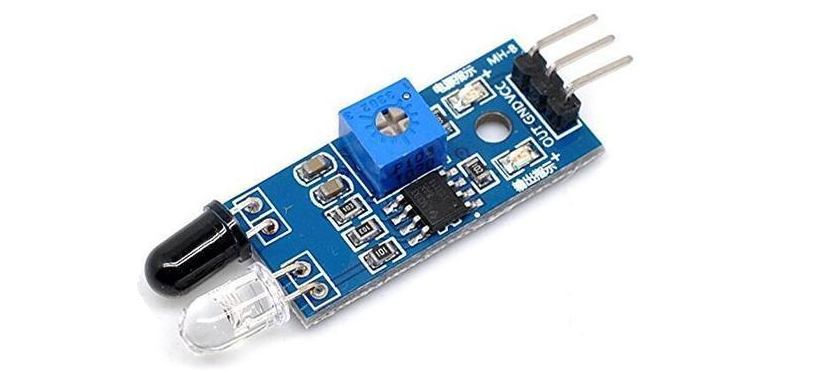An infrared (IR) sensor is a device that identifies and measures IR in its surrounding environment. Infrared radiation is electromagnetic, with lengthier wavelengths compared to visible light but shorter wavelengths than radio waves. It is emitted by objects due to their temperature.
The basic principle behind an infrared sensor is the detection of heat energy emitted by objects. When an object is at a temperature above absolute zero (-273.15 degrees Celsius or -459.67 degrees Fahrenheit), it emits infrared radiation. An IR sensor can detect and convert this infrared radiation into an electrical signal, which can then be interpreted by electronic circuits or microcontrollers.
Infrared sensors are commonly used in various applications, including:
Proximity and motion detection: IR sensors can detect the presence or movement of objects within their field of view. They are often used in automatic doors, burglar alarms, and occupancy sensing systems.
Temperature measurement: IR sensors can measure the temperature of objects without making physical contact. They are used in non-contact thermometers, industrial temperature monitoring systems, and HVAC (heating, ventilation, and air conditioning) systems.
Remote controls: Many remote controls, such as those used for televisions and air conditioners, utilize IR sensors to transmit signals to the corresponding devices.
Security systems: Infrared sensors can be part of security systems, triggering alarms when they detect the presence of intruders or unauthorized individuals.
Object tracking and robotics: Infrared sensors can be used to track the movement of objects or individuals, making them useful in robotics, automated guided vehicles (AGVs), and object tracking systems.
Environmental monitoring: IR sensors can be employed to measure and monitor various environmental factors such as humidity, gas levels, and air quality.
Infrared sensors play a crucial role in numerous fields where the detection of heat or motion is essential, offering a non-contact and reliable method for capturing information about the surrounding environment.
What are the Features of Infrared Sensors?
Infrared sensors have various features that enhance their functionality and adaptability to different applications. Here are some common features found in infrared sensors:
- Sensing range
- Field of View (FOV)
- Sensitivity
- Response time
- Emitter and detector type
- Analog or digital output
- Filtering and signal processing
- Communication Interface
- Power requirements
- Environmental considerations
It’s crucial to note that the specific features of an infrared sensor can vary depending on the manufacturer, model, and intended application. Therefore, it’s essential to consult the sensor’s datasheet or product documentation for detailed information about its features and specifications.
Infrared sensors offer several benefits in various applications. Here are some of the key advantages:
Non-contact sensing: Infrared sensors do not require physical contact with the object or target being measured or detected. This feature makes them ideal for applications where contact could be impractical, dangerous, or undesirable.
Detection in low-light or dark environments: Infrared sensors can operate effectively in low-light or completely dark environments since they detect infrared radiation rather than relying on visible light. This makes them suitable for applications such as night vision devices, security cameras, and intruder detection systems.
Fast response time: Infrared sensors can provide rapid detection and response. They can quickly detect changes in temperature or motion and provide an immediate output signal, allowing for swift reactions in automated systems and real-time monitoring.
Wide range of applications: Infrared sensors have versatile applications across various industries and sectors. They are used in consumer electronics (remote controls, smartphones), automotive (collision avoidance, driver assistance), industrial automation (proximity sensing, temperature monitoring), healthcare (non-contact thermometers), and more.
Energy efficiency: Infrared sensors typically consume low amounts of power, making them energy-efficient devices. They can operate for extended periods without draining batteries or causing excessive power consumption in larger systems.
Immunity to visible light interference: Infrared sensors are designed to detect infrared radiation specifically, so visible light does not affect them. This allows them to function reliably even in environments with strong ambient lighting or in the presence of direct sunlight.
High precision and accuracy: Infrared sensors can provide precise measurements and detection. They can capture subtle temperature variations or small movements, allowing for precise control in applications such as temperature monitoring, object tracking, and motion detection.
Cost-effective: Infrared sensors are generally cost-effective, especially considering their wide range of applications and benefits. They balance performance, functionality, and affordability well, making them accessible for various industries and consumer products.
Finally, the benefits make infrared sensors popular in numerous fields, enabling automation, enhancing safety, improving efficiency, and facilitating advanced monitoring and control systems.


Leave a Reply